


ZOOS VICTORIA MAGAZINE CONTEMPORARY THINKING ON WILDLIFE & ZOO-BASED CONSERVATION All wildlife tiny and tall Citizen scientists Melbourne Zoo turns 160 ISSUE #13 SPRING/SUMMER 2022 Fight for flight Working to save the Golden-rayed Blue Butterfly
Your monthly tax deductible gift of $15 or more will support us to ensure the animals at our zoos continue to receive world-class care every day of the year, and help us fight extinction. Choose which animal species to adopt today at zoo.org.au/animal-adopters
How you're having an impact
Giving world-class care to the animals at our three zoos.
Providing enrichment to the animals in our care.
Supporting conservation work to fight extinction.

Hello!
As the promise of spring has well and truly blossomed, it is encouraging to see our city streets filled with an abundance of life. Pollinators are taking as much interest in the colourful floral displays of the season as I am. A reminder that wildlife is, and always has been, at our doorstep.
I am encouraged by the shared passion of our zoo community for fighting wildlife extinction. It is through collaboration and the help of our supporters that we are able to take critical conservation actions. Together, we are securing a future rich in wildlife for generations to come. With Kyabram Fauna Park officially under the Zoos Victoria banner, our community has even more beautiful spaces for people to immerse themselves in nature.
In this edition of ZV magazine, we’re celebrating our 160th birthday. We’ll look at how far we have come, and the incredible conservation work we are able to do now and into the future, thanks to the generosity of all our supporters. From little Spotted Tree Frogs to giant elephants, we take a peek at how Zoos Victoria is working to prioritise the conservation of wildlife tiny and tall.


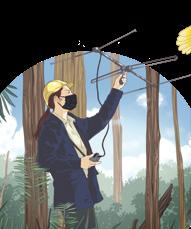
We also recognise the achievements of citizen scientists. The research and conservation projects that Zoos Victoria undertakes each year would not be possible without the commitment and passion of the citizen scientists who contribute their time and energy every day. And we take a look at the habitat conservation and restoration programs key to the long-term survival of the Endangered Golden-rayed Blue Butterfly, the only species of butterfly known to be endemic to Victoria.

I hope you enjoy reading these articles and more in this edition. I would like to extend a heartfelt thank you for your ongoing support of all that we do.

All shapes and sizes
Protecting all wildlife tiny and tall

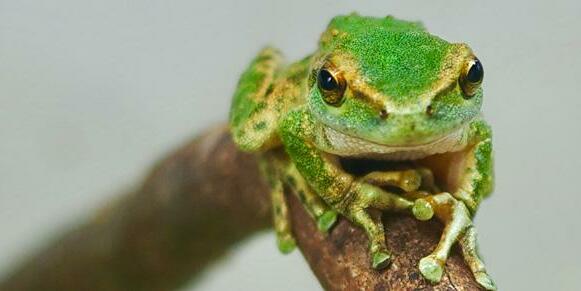 Melbourne Zoo turns 160
Melbourne Zoo turns 160
friends
donors list
Dr Jenny Gray / CEO, Zoos Victoria
Citizen scientists
Hopping to the rescue
16
Plus 22 Our feathered
23 Partners &
08 12
20
3 SPRING/SUMMER 2022
ANIMAL

ZVMAG
Butterflies on the brink
Habitat conservation and restoration programs are key to the long-term survival of the Endangered Golden-rayed Blue Butterfly, the only species of butterfly known to be endemic to Victoria.
WORDS Jo Stewart ILLUSTRATION Phil Constantinesco
The Golden-rayed Blue Butterfly may not be a household name, but awareness of this local invertebrate species is slowly growing since being added to Zoos Victoria’s Fighting Extinction priority list in 2019.
A demure butterfly with veins of gold along its inner wing, the delicate Golden-rayed Blue Butterfly is found only in very limited habitat along the margins of ephemeral salt lakes within the Wimmera region of Victoria. With such small patches of territory to call home, the modest populations of this mysterious butterfly are in a highly vulnerable position.
“The small patches of suitable habitat for this species are surrounded by cropping and grazing country, so both habitat fragmentation and degradation are an issue,” says Dr Michael Magrath, Research Manager with Zoos Victoria’s Wildlife Conservation and Science team.
Apart from contending with little remaining habitat, the butterfly is dependent on only one type of plant: Myoporum parvifolium (also known as Creeping Boobialla).
The species uses myoporum as both a food source and a place to lay eggs, so the entire life cycle of the Golden-rayed Blue relies on this one native flowering plant.
If the amount of myoporum growing in these patches declines further, the remaining populations of Golden-rayed Blues will be at risk of disappearing. With the species in such a precarious position, something must be done now to boost its odds of survival, before it’s too late.
Surveying the land
Enter: Fabian Douglas, an ecologist and butterfly expert who first described the species back in 2004. Funding from Zoos Victoria’s Fighting Extinction program enabled Fabian to undertake important field work to learn more about this elusive, native invertebrate.
Importantly, the survey conducted by Fabian and staff from Zoos Victoria in December 2021 led to the known distribution of the species being extended by 35 kilometres to the north and south. With the species only active and flying from November to late summer, this type of field work must be timed to coincide with the warmer months of the year.
Name Golden-rayed Blue Butterfly Class Invertebrate Status Endangered Region
Wimmera, western Victoria FACT
FILE 5 SPRING/SUMMER 2022 GOLDEN-RAYED BLUE BUTTERFLY
ANIMAL
Zoos Victoria and partners are also developing an action plan to counter further population decline. Securing the preferred habitat of this butterfly is key to its survival, so conservation and revegetation work is currently the prime focus of the program.

“Invasive weeds are affecting most of the sites occupied by the butterflies. There’s also some encroachment by a native paperbark species at some sites,” Dr Magrath says.
He explains that Lake Wyn Wyn Wildlife Reserve (the area where this species was originally found) has an abundance of salt paperbark. While a native species, this paperbark displaces the myoporum that the Golden-rayed Blue needs to survive.
Collaborating for conservation
To secure some sites, the team is planning to undertake revegetation trials of the myoporum host plant and also remove invasive weeds from areas where they are most damaging.
“An additional option being considered is translocating the species between patches,” Dr Magrath says, explaining that translocation could be used to establish new populations in locations that have suitable habitat, but are currently unoccupied by the butterfly and quite isolated from existing populations.
Of course, threatened species recovery work of this nature requires contributions from a range of people and organisations. While captive breeding forms a critical element of many other threatened species recovery programs, habitat conservation and revegetation efforts are likely to be the focus for the Golden-rayed Blue Butterfly.
“We will be working with partners like Parks Victoria, Landcare, Trust for Nature, DELWP [Department of Environment, Land, Water and Planning] and local landholders,” Dr Magrath explains. Zoos Victoria is also partnering with the team from Dalki Garringa (which means ‘Good Growing’ in Wergaia language), a Wimmerabased native nursery owned and managed by the Barengi Gadjin Land Council. The nursery will be responsible for growing the myoporum plants needed for the revegetation trials.
Raising funds, increasing awareness
Funding is essential to the viability of projects like this, with funds needed to cover the costs associated with conducting research and revegetating and conserving the land. That’s why Zoos Victoria’s Totes for Wildlife is adding a new Golden-rayed Blue Butterfly tote to the collection – the first time an invertebrate has been included in the range. Each Golden-rayed Blue Butterfly tote bag purchased either on site at the Zoo or online via the Zoo Shop will raise muchneeded funds to support the recovery of the species.
“We’ve been running Totes for Wildlife for a few years now. We’ve highlighted birds and mammals in the past, but we thought it was really important to also talk about one of our local threatened invertebrates as well. They’re found nowhere else except Victoria, and we want to provide our visitors, supporters and members with a chance to
Pictured (clockwise from above) The Golden-rayed Blue Butterfly has delicate golden veins along its inner wing; its habitat is limited to the margins of ephemeral salt lakes in Victoria’s Wimmera region; Myoporum parvifolium (also known as Creeping Boobialla) is its only food source.
IMAGES: KATE PEARCE, ED DUNENS
6ZVMAG
DR MICHAEL MAGRATH, RESEARCH MANAGER – WILDLIFE CONSERVATION AND SCIENCE TEAM, ZOOS VICTORIA

help them, because they’re a pretty special species,” says Peter Lancaster, Zoos Victoria’s Community Conservation Campaigner.
Apart from raising funds for the revegetation project, this Totes for Wildlife campaign aims to boost the profile of this unique native invertebrate that most Victorians wouldn’t have seen or heard of before.
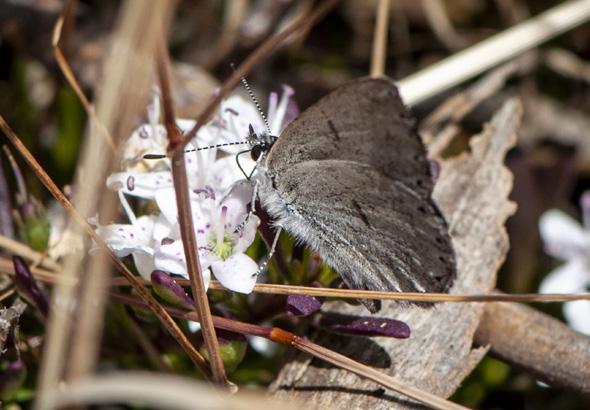
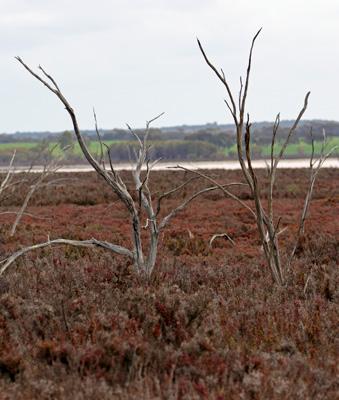
“The bag designs are quite bright and colourful. We want the people using these bags in their everyday life to start conversations and get people talking about the species. One of the key outcomes is that we hope to see people recognising this species more and showing more care for the long-term future of the Golden-rayed Blue,” Peter says.
There are also plans to increase awareness of the species via signage and displays at Melbourne Zoo.
Dr Magrath explains that, beyond the Goldenrayed Blue Butterfly, we all need to consider the bigger picture when it comes to invertebrates. Apart from supporting conservation programs, he hopes more Victorians will be inspired to plant native trees and shrubs in their backyards to provide habitat for the insects that play an essential role in maintaining healthy ecosystems.
“It’s not just about this species. Both locally and globally, many invertebrate populations are in serious decline. They play a fundamental role in supporting ecosystems, for example as pollinators and as critical food sources for many other animals. There’s no question that many are in trouble and we must act now.”
TAKE A BUTTERFLY UNDER YOUR WING
Support work to save the Golden-rayed Blue Butterfly and other local threatened species by signing up to the Zoos Victoria Animal Adopters program. zoo.org.au/animal-adopters
You can also purchase your Totes for Wildlife tote featuring the Golden-rayed Blue Butterfly from any of the zoos shops or online at shop.zoo.org.au/collections/totes-for-wildlife

It’s not just about this species. Both locally and globally, many invertebrate populations are in serious decline.
7 SPRING/SUMMER 2022 GOLDEN-RAYED BLUE BUTTERFLY
Protecting all wildlife: TINY AND TALL
 WORDS Stephanie Convery
WORDS Stephanie Convery

e know the Zoo is for creatures of all shapes and sizes, but it’s the ‘greater’ animals, like Asian Elephants, that immediately come to mind. They’re large, distinctive– and you’re not going to see them anywhere else – in Australia, at least. But Zoos Victoria is committed to caring for and improving the fortunes of all animals – from large exotic species to tiny native amphibians. This year, just in time for Melbourne Zoo’s 160th birthday, the resident elephant population is due to have some birthdays of its own.
WWithin the Zoo’s award-winning Trail of the Elephants, three calves are due towards the end of 2022 and the start of 2023. After 22-month pregnancies, females Dokkoon, Num-Oi and Mali will each give birth to calves sired by Luk Chai, a 13-year-old male Asian Elephant who arrived in Melbourne from Taronga Western Plains Zoo, Dubbo, in December 2020.
Trail of the Elephants keeper Lucy explains that having three calves born at a similar time sets them up in the best possible way.
“The best welfare option for elephants when they are born into a herd is to have other calves to play with. So, when they develop and grow, they have each other to interact with socially and physically.
“Mothers are there to support the calves
From little Spotted Tree Frogs to giant elephants, Zoos Victoria is working to prioritise the conservation of all animals – whether they are tiny or tall.
8 ANIMAL
ZVMAG
in terms of feeding and guiding them. But the calves really need playmates. It is ideal to have more than one calf born into a herd so they can play, grow and learn together, creating excellent life skill development opportunities. This mimics natural herd structures in the wild,” Lucy says.
The calves will be born at Melbourne Zoo, and parts of the trail will be closed off to allow a calm environment for the mothers and their newborns.


Once they’re healthy and strong, the youngsters will venture into areas of their habitat where visitors can see them. They won’t spend their whole lives at Melbourne Zoo, though: in 2024, the entire herd will be moving to Werribee Open Range Zoo, where the elephant habitat is being expanded to 21 hectares, thanks to an $84 million grant from the Victorian Government.
But habitat is only part of the story. A lot of resources and infrastructure are needed to properly care for elephants even simply moving them to their new home is a complicated and expensive project. Thanks to the generosity of the Fox family via the Linfox team, work has already commenced to put the right supports in place to move the growing family. Further donor support will be critical to their final move to Werribee in 2024.
Equally important is the conservation work that goes on for all the tiny creatures we may only rarely see during a Zoo visit.
Consider the Spotted Tree Frog. This alluring native amphibian comes in a variety of colours and patterns, from bright to mottled green, to its namesake coppery brown with dark spots. Spotted Tree Frogs make their homes in the mountain streams of north-eastern Victoria and southern New South Wales, but the population has declined so much that the species is now Critically Endangered, with fewer than 1,500 left in the wild – a very low number in frog terms.
WHAT TO EXPECT WHEN AN ELEPHANT IS EXPECTING
Elephant reproduction starts with a female elephant entering oestrus, a hormonal period that happens approximately every three to four months, which male elephants – called bulls – can detect by smell. Bull elephants also enter a hormonal cycle of their own called musth, during which they can have a more aggressive reproductive urge. Soon after arriving in Melbourne, bull elephant Luk Chai was successfully introduced to female elephants, Dokkoon, Num-Oi and Mali. Their three calves will grow up together with grandmothers, mothers, aunties and cousins as part of a closely bonded herd, playing and socialising with each other as all the female elephants share the job of raising them. Their father will also get to know and bond with them while they are young – mimicking the natural cycles of the wild.
Top to bottom Elephants interacting at Melbourne Zoo; Dokkoon with her offspring Mali; Man Jai, brother to Mali.

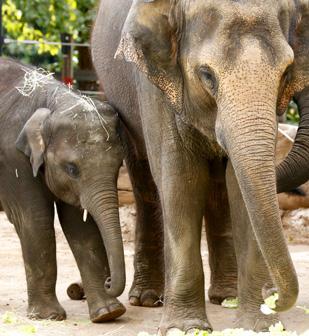
9 SPRING/SUMMER 2022
CONSERVATION
IMAGES: JO HOWELL, RICK HAMMOND, MEGAN CROUCHER
Damian, Melbourne Zoo’s Specialist Keeper for amphibian conservation programs, explains that, despite being small and often unnoticeable, frogs play as significant a role in their ecosystems as larger animals.
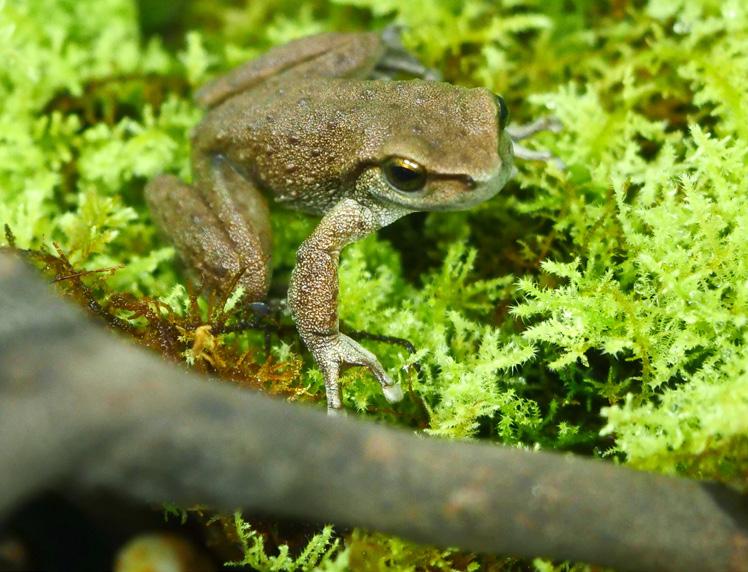
“Spotted Tree Frogs help keep our mountain streams intact by providing an important link in the food chain so all native species can flourish. Their unique acoustic call also adds to the soundscape of the sub-alpine forests,” explains Damian.
Conservationists have been monitoring Spotted Tree Frogs since 1958, and more accurately since the early 1990s. The species is lucky in this respect: “This long-term monitoring program represents one of the most robust investigations for a threatened species in Australia,” Damian says. “These intense surveys provide ecologists with an accurate record of historical populations, giving a clear indication of the rapid decline in population numbers.”
The surveys have also helped identify the frog’s main threats: non-native fish including


trout and redfin, released into waterways for recreational fishing, and chytrid fungus, an introduced pathogen. Zoos Victoria has a small population of Spotted Tree Frogs in captivity at Healesville Sanctuary and Melbourne Zoo, but to bring the species back from the brink, more is needed – starting with the development of a larger-scale breeding program to support reintroduction of frogs back into the wild, and increasing the wild population of frogs at key environmental refuge sites.
“They might not be as visible and recognisable as elephants, but Spotted Tree Frogs need the help of donors too,” says Angie Retallack, General Manager, Philanthropy at Zoos Victoria. We are thankful to the CalvertJones Foundation, who recently supported our first steps to establish a captive breeding program; Angie hopes others will follow suit.
“From bequests and major gifts to even just small gifts – it all adds up,” she says. “In this economic environment where everybody’s tightening their belts, our important conservation work isn’t going to stop.”
SAVING THE SPOTTED TREE FROG
Spotted Tree Frogs lay their eggs amongst rocks on the banks of fast-flowing streams. Once hatched, the tadpoles grip on to rocks with their mouths to prevent being washed away. Unfortunately, this species has now disappeared from more than 50 per cent of its known habitat in Victoria, and rapid decline has beset the remaining populations. It’s essential that conservationists arrest the spread of invasive chytrid fungus, protect remaining habitat through bushfire management and create wild safe havens by managing non-native fish populations. At the same time, the critically important work of establishing and maintaining a captive population of Spotted Tree Frogs and developing a breeding program to support recovery of the species goes on at Healesville Sanctuary and Melbourne Zoo.
Above, left to right The Spotted Tree Frog in its natural habitat in the mountain streams of northeastern Victoria; a Spotted Tree Frog tadpole.
Spotted Tree Frogs help keep our mountain streams intact by providing an important link in the food chain so all native species can flourish.
DAMIAN / SPECIALIST AMPHIBIAN KEEPER, MELBOURNE ZOO
10ZVMAG ANIMAL
IMAGES: DAMIAN GOODALL, JO HOWELL
“We have become the stewards of our planet, and we have amazing powers – to destroy, or protect, we have that power and I think ethically we are obligated where we can to preserve species, to do what we can to stop them from going extinct.”


Move closer to our work by making a gift to one of our projects and make a real difference for some of the world’s most endangered animals. Giving a major gift is much more than a financial transaction; it is inspiring others to give, changing animals’ lives for the better and helping move species off the critically endangered list.


BECOME A CONSERVATION PARTNER For more information visit zoo.org.au/donate/conservation-partners Annual Levels of Support $5,000 Fighter $10,000 Champion $25,000 Hero $50,000 Influencer $100,000 Leader $250,000+ Visionary
ELIZABETH FINKEL / CONSERVATION PARTNER
On the shoulders of citizen science
The research and conservation projects that Zoos Victoria undertakes each year would not be possible without the commitment and passion of the citizen scientists who contribute their time and energy every day.
 WORDS Alegria Alano ILLUSTRATION Phil Constantinesco
WORDS Alegria Alano ILLUSTRATION Phil Constantinesco
CONSERVATION IMAGES: JO HOWELL
12ZVMAG
Thorough scientific research underpins the work that goes into the recovery and conservation of the 27 priority threatened species at Zoos Victoria. This research involves a lot of work both in and out of the zoos, through multiple projects that wouldn’t be possible without volunteer organisations and the commitment and passion of our citizen scientists.
Citizen scientists are members of the public with varied knowledge, skills and expertise, who help with research or data collection. Zoos Victoria is currently involved with more than 70 research
Community care

Citizen science can also mobilise local communities to get involved in the conservation of animals that share their space. The release of Eastern Barred Bandicoots on French Island is a great example of community involvement.
Eastern Barred Bandicoots were classified as Extinct in the Wild on the mainland due to predation and habitat loss. Thanks to releases into fenced sites and islands, this species’ recovery is well underway. In 2019, 72 Eastern Barred Bandicoots were released onto French Island and have been closely monitored by scientists and volunteers ever since.
“One of the projects I lead is monitoring the Eastern Barred Bandicoots to understand
projects across the biological and social sciences, some of which are driven by community members.
“There are lots of different types of citizen science projects, ranging from identifying wildlife in camera trap images – each quarter I have around 500,000 camera trap images that require sorting; reporting Bogong Moth sightings; and assisting with population monitoring to collect breeding and health information on individual animals,” says Dr Amy Coetsee, a Threatened Species Biologist at Zoos Victoria.
their habitat use, changes in population size over time and spread across the island,” Dr Coetsee says. “There is no way I could monitor them on French Island all by myself –it is a huge undertaking.”
Luckily, Dr Coetsee has the help of two dedicated locals: Jenny, who lives on acreage adjacent to the release site, and Judy, who lives on the neighbouring farm. Jenny and Judy both wanted to get involved after hearing Dr Coetsee speak at a community talk – and because of the ‘cuteness’ of the Eastern Barred Bandicoots, according to Judy.
One of the projects I lead is monitoring the Eastern Barred Bandicoots. There is no way I could monitor them on French Island all by myself – it is a huge undertaking.
DR AMY COETSEE / THREATENED SPECIES BIOLOGIST, ZOOS VICTORIA
13 SPRING/SUMMER 2022 VOLUNTEER GROUPS
JUDY / CITIZEN SCIENTIST
“I got the cameras first then Judy wanted to get photos too, so it became a bit of a competition,” Jenny says.
Both women have invested heavily in the program by purchasing their own camera equipment and spending at least a few hours a week setting up cameras and sorting through photos. “If it’s a windy day you might get 2,000 photos on your camera because of a bit of grass blowing in front of the trigger,” Jenny says.
In the end, both felt that the investment was well worth it. “It’s fun to see what’s happening on the island and to see that the success of the release program has been huge,” Jenny says.
Judy adds, “I think it has opened our eyes to what we can do as far as keeping an eye on the animals… It’s also fun to see what other animals are around and watch their antics!”
Jenny and Judy also help with the biannual population monitoring in the release site ‘Bluegums’, part of the French Island National Park. “I have volunteers who help me trap twice a year so we can assess health and breeding status, and get an idea of population size,” Dr Coetsee says. Through all this hard work and collaboration, wild Eastern Barred Bandicoots have been reclassified from Extinct in the Wild to Endangered.
Expert breakthroughs
Terry is a retired researcher who previously worked at the South Australian Museum and has volunteered on various Southern Bent-wing Bat programs since the year 2000.

Southern Bent-wing Bats were once numerous across southern Australia – now they are Critically Endangered. Each year, the bats return to maternity caves at Naracoorte in South Australia and Warrnambool in Victoria. This annual convergence is an ideal scenario for measuring the population size and trend, albeit technically difficult.
“We developed this project late last year using high-resolution infrared cameras with
I think it has opened our eyes to what we can do as far as keeping an eye on the animals...
CONSERVATION
14ZVMAG
infrared lights to record the bats that fly out. My colleague Paul, who is a data analyst, has come on board to write apps,” Terry explains. The pair have worked to install a permanent camera system at Naracoorte that’s linked to a computer and a modem.
“It’s required an enormous amount of work on Paul’s behalf, particularly writing all the software,” Terry says. “We started this project with infrared cameras on our own, but Zoos Victoria came on board and gave a generous grant to support the project which allowed us to buy all the equipment.”
Dr Coetsee says the pair’s commitment has been extremely valuable. “The hard work of volunteers investing significant time to develop and set up the automatic monitoring system means that we will have a much better understanding of the number of bats using the cave each night,” she says.
“Have a look at what projects are happening in your area and see if you can get involved.”
Community groups may have opportunities to volunteer as a citizen scientist, for example, the Friends of Naracoorte Caves and the Friends of the Helmeted Honeyeater.

Zoos Victoria also supports programs that people can participate in at home. ‘Moth Tracker’ is a platform for citizens to record sightings of migrating Bogong Moths, which are the main food source for the Critically Endangered Mountain Pygmy-possum.
Members of the public are also encouraged to get involved with the Australian Museum’s FrogID citizen science project, that records frog calls to document species diversity, distributions and breeding habitats of Australian frogs.
Involvement creates opportunities for the broader community to connect with wildlife.
“For a lot of the volunteers, seeing bats close up is a rewarding thing for them,” Terry says.
On French Island, Judy shares a similar experience: “My husband has been here all his life – he’s nearly 80 – and he has never seen some of the wildlife that I’ve seen. For him, it’s amazing to see.”
This connection is key to ensuring continued support for conservation programs and encouraging new volunteers. “Volunteer help is critical to any of these projects working,” Terry says.
Terry hopes to set up the systems to allow local volunteers to take over the counting. He is also working on writing a methodology for this ground-breaking process that can be shared with other research teams.
Get involved
Dr Coetsee stresses that anyone can work on citizen science programs. “Enthusiasm to be involved is all that’s usually needed,” she says. “I always provide training and ongoing support to my volunteers.
Fighting extinction is impossible for any individual, but many people sharing time, money, knowledge and enthusiasm makes it possible.
WANT TO HELP?
If you’re interested in becoming a citizen scientist, an easy place to start is with the Moth Tracker (visit swifft.net.au/mothtracker) or FrogID (frogid.net.au/frogs). The more people who can contribute to these projects, the more data the scientists will have to work with.
Enthusiasm to be involved is all that’s usually needed ... Have a look at what projects are happening in your area and see if you can get involved.
DR AMY COETSEE / THREATENED SPECIES BIOLOGIST, ZOOS VICTORIA
15 SPRING/SUMMER 2022 VOLUNTEER GROUPS
THEN
Celebrating 160 years
W hen Melbourne Zoo first opened at Royal Park in 1862, the world was a different place. The US Civil War was in full swing, Queen Victoria had been on the throne for less than half her eventual reign and Melbourne was still in its infancy, having only officially been a city for 15 years.
Since then, Melbourne Zoo has changed immensely with the times.
Even before settling into its current home, the Zoo had been through several incarnations. First planned as an ornithological society, it had broadened its scope to include mammals and fish, which were first housed at the Royal Botanic Gardens, later Richmond Paddock and finally Royal Park. Its purpose, too, had taken on various forms, and in those early years, there was plenty of debate about whether its main objective should be to study animals, entertain the public or acclimatise foreign wildlife into the local environment.
Ultimately embracing all three aspects, but with a particular focus on acclimatisation, the Zoo started out with just an assortment

Throughout its long history, Melbourne Zoo has changed with the times, as we have learnt more about animal welfare and the importance of protecting wildlife for future generations.
WORDS Beth Wallace ILLUSTRATION Phil Constantinesco
THEN
16 COMMUNITY ZVMAG
of pheasants, quail and trout – plus a few monkeys and some camels left over from the ill-fated Burke and Wills expedition.
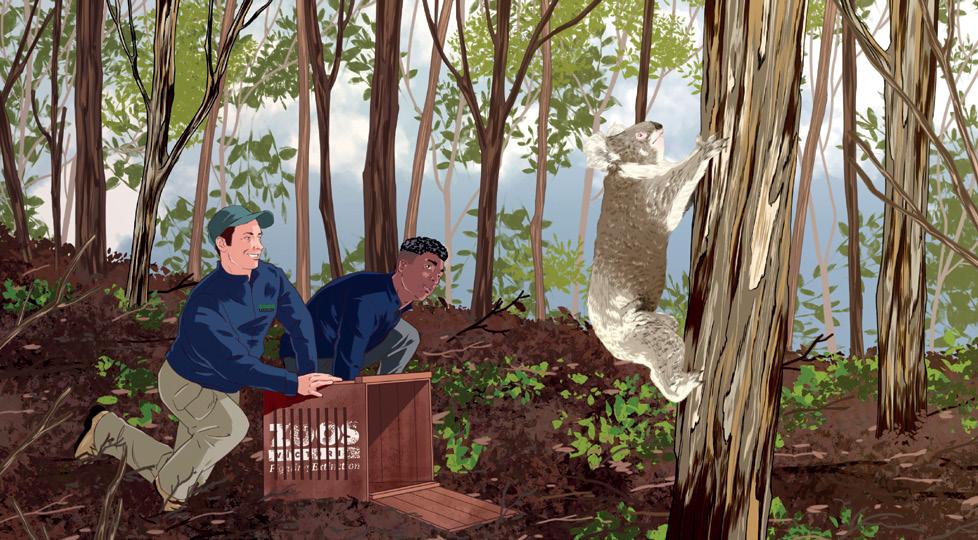
“Given this lack of ‘exotic’ animals, it was the formal gardens, inspired by London Zoo, that provided the main attraction,” says Karen Rawady, the Zoo’s unofficial historian – and Plant Collections and Landscape Technical Support Officer. “The gardens were established primarily along the central axis, but it was like a glorified farm, with Brahman cattle and deer, as well as goats and sheep in open paddocks,” she explains. “In fact, the Zoo would enter competitions, sending its Angora goat fleece over to England, where it won awards.”
For the first 20 years, Society members’ subscriptions and donations were the primary source of income, and entry to the public was provided free of charge; however, financial difficulties led to the introduction of an admission fee in 1881. People came from far and wide to see the expanding assortment of animals, which by 1883 included lions, tigers, bears, eland, a panther, and the Zoo’s first elephant Ranee. By the early 1900s, a variety of sideshows and concerts drew in crowds, as well as rides on a miniature train, donkey
carriages and elephants. Right up until 1962, Asian Elephants, Betty and Peggy, carried hundreds of visitors around the perimeter of the current-day Carousel Park.
Karen explains that the end of elephant rides coincided with a “global wakeup call” regarding animal welfare and a growing awareness of conservation issues. During the 1960s, many zoos collectively set out to improve their exhibits, giving greater consideration to the animals’ psychological and physiological needs.
KAREN RAWADY / PLANT COLLECTIONS AND LANDSCAPE TECHNICAL SUPPORT OFFICER (AND UNOFFICIAL MELBOURNE ZOO HISTORIAN), ZOOS VICTORIA

... It was like a glorified farm, with Brahman cattle and deer, as well as goats and sheep in open paddocks.
TODAY TODAY 17 SPRING/SUMMER 2022
“Luckily, we had Alfred Dunbavin Butcher as Chairman of the Board at that time, and he encouraged the government and public to fund a huge update of the Zoo,” Karen says. She highlights the opening of Lion Park in 1967 as one of the earliest examples of this new ‘zoos without bars’ philosophy, adding: “Although the animals had a fence around them to keep them contained, they had open grass, with rocks to lounge on and caves to hide in. There was also an overpass for visitors to walk across, making it one of the first places in the world that allowed people a birds-eye view in the middle of an exhibit.”
Other notable changes under Alfred Dunbavin Butcher’s guidance included the opening of the Butterfly House, the removal of fences around the elephants in favour of a moat, and a new Reptile House.
In the 1980s, Melbourne Zoo initiated its biggest overhaul yet, grouping species from similar habitats together into bioclimatic zones – a concept still seen today in the Gorilla Rainforest, Melbourne Zoo’s Butterfly House and Trail of the Elephants. In these (and other) precincts, gardeners have worked to create an immersive experience for visitors, using a mixture of plants from the animals’ wild habitats alongside Australian native plants to cultivate a strong sense of place. “Recreating as much as possible of the landscape and the environment from which a species naturally comes not only benefits the animal, but also helps with the education and conservation message that Zoos Victoria has made its mission,” explains Karen.
Though Melbourne Zoo has been involved in various conservation projects throughout
FROZEN
IN TIME
Stored safely in sub-zero temperatures within Melbourne Zoo’s historic veterinary precinct lies a treasure trove of history: thousands of samples of blood serum drawn from current and former animal residents.

This priceless collection, which includes samples dating back to the early 1990s, supports critical research into animal wellbeing, explains Melbourne Zoo Head of Veterinary Services, Dr Michael Lynch. “We can track changes in a living individual animal’s health over time, but we can also conduct longerterm population studies of a particular species by comparing individual animals,” he says. “Many of the animals represented here are no longer with us, but in this way, they are still making a valuable contribution to our animal healthcare science.”
its history, in recent years, its commitment to wildlife conservation has taken centre stage. Thanks to the generous support of members and donors, emergency breeding programs undertaken by the Zoo and its partners have staved off the extinction of species including the Eastern Barred Bandicoot, the Helmeted Honeyeater and the Baw Baw Frog. Given the momentous challenges facing our planet, the Zoo also now plays an essential role in educating the community about the importance of protecting our natural environment.
For long-time donors Joy and Ken Barassi, it is this dedication to conservation that makes the present-day Zoo such a special place. “I think the great thing Melbourne Zoo does is show animals in a way that people then form an attachment to them,” Joy says. “Once you love that animal, you care that it’s taken care of and doesn’t become extinct – whatever steps need to be taken.”
The couple have many fond memories linked to Royal Park, having attended many jazz nights, participated in Friends of the Zoo events and, most notably, sponsored the Red Pandas since 1977. Even now, they enjoy pointing out the elusive creatures to fellow visitors. “They hide high up in the trees and can be hard to see. When we go to the enclosure and kids come along with their parents, we show them where to look, and they get very excited,” Ken says.
Like Joy and Ken, retired kindergarten teacher Joan Macdermid loves to see young people connecting with animals. Having visited the Zoo many times with her own (now adult) daughters, she signed up as a volunteer in 1999, first assisting with school holiday
1857
The Zoological Society of Melbourne formed, housing its first collections in Richmond Paddock.
1862 Melbourne Zoo opened its current site at Royal Park. Entry for the public was free of charge.
1883
People came from far and wide to see Ranee, the Zoo’s first elephant. Lions, tigers, bears, eland and a panther also proved big attractions.
1900s
Sideshows, concerts and miniature train rides continued to draw crowds.
1960s
Many zoos around the world began to redesign their exhibits around the animals’ psychological and physiological needs.
MELBOURNE ZOO MAJOR MILESTONES
18ZVMAG COMMUNITY
1967


Lion Park at Melbourne Zoo was one of the earliest examples of the new ‘zoos without bars’ philosophy. The Butterfly House opened soon afterwards, and the fences around the elephants were replaced with a moat.
1980s
Melbourne Zoo began grouping species from similar habitats together into bioclimatic zones – a concept still seen today in the Gorilla Rainforest, Butterfly House and Trail of the Elephants.

Left Melbourne Zoo has evolved with the times, although the main entrance hasn’t changed all that much since it was pictured here c.1940; a Brunswick cable tram taking passengers via the Zoo in 1942.

programs and later joining the philanthropy department. Throughout this long association, Joan has seen the Zoo “move with the times”, and these days, admires its efforts to inspire an appreciation for all living things in its young visitors. “I find it difficult to imagine that there’s a possibility in 50 years that children will grow up never seeing a live elephant or a koala,” she says. “But I think the Zoo is trying so hard to remedy that.”
As time goes on, Melbourne Zoo will no doubt continue to evolve – constantly renewing its focus on education and conservation, in line with the changing challenges of our time. It is a far cry from its first inception. As part of Zoos Victoria, a zoo-based conservation organisation dedicated to fighting wildlife extinction, it is leading by example, the future of zoos.
TAKING THE ZOO INTO THE FUTURE
By joining the Future Hands Fellowship and leaving a gift in your will to Zoos Victoria, or contributing to the Endowment Fund, you’ll create a lasting legacy – helping us safeguard the future of the animals in our care and fight extinction for many years to come. For more information, visit zoo.org.au/donate/future-hands-fellowship
TODAY
Breeding programs undertaken by the Zoo and its partners have staved off the extinction of species including the Eastern Barred Bandicoot, the Helmeted Honeyeater and the Baw Baw Frog.

Once you love that animal, you care that it’s taken care of and doesn’t become extinct – whatever steps need to be taken.
JOY AND KEN BARASSI / LONG-TIME DONORS
IMAGES:
GUS GOSWELL HAROLD PAYNTING COLLECTION, STATE LIBRARY OF VICTORIA; CHARLES SMALLWOOD, STATE LIBRARY OF VICTORIA 19 SPRING/SUMMER 2022
Prague Zoo hops to frog,s rescue
WORDS Steve Colquhoun
It’s said that hard times reveal the truest friends. So it proved in the aftermath of the devastating Black Summer bushfires, as donations and assistance poured in from around the world to help Zoos Victoria mobilise an unprecedented recovery effort. The influx of funding helped staff provide frontline first aid and longer-term medical treatment and rehabilitation for koalas, kangaroos, possums and dozens of other species caught in the path of wildfires that raged across swathes of Victoria and New South Wales.
The incredible response also strengthened the bonds between Zoos Victoria and a new partner. In the Czech Republic, Prague Zoo responded to the bushfire emergency by initiating a substantial fundraising effort that raised $1.3 million, which it shared among several key Australian organisations including Zoos Victoria.
MIROSLAV BOBEK / DIRECTOR OF PRAGUE ZOO
Above from left Prague Zoo is helping the Critically Endangered Southern Corroboree Frog and fund genetic research on the Lord Howe Island Stick Insect; Dr Jenny Gray and Miroslav Bobek have been long-time acquaintances.
And that wasn’t the end of the story. Prague Zoo has since become a crucial benefactor in several of Zoos Victoria’s ongoing species conservation and rehabilitation projects.
Most notably, it has donated more than $400,000 to aid efforts to save the Critically Endangered Southern Corroboree Frog. Disease and climate change – including the effects of the 2020 bushfires – have decimated the

From half a world away, a surprising benefactor is driving the effort to save one of our most Critically Endangered species.
We are all in the same boat. We have a basic, common goal. It is essential that we work together and support each other.
PHILANTHROPY
20ZVMAG
distinctive amphibian, reducing numbers in the wild to fewer than 50.
The donation is helping to construct new field enclosures in the frog’s sole habitat, Kosciuszko National Park in southern New South Wales, and repairing existing enclosures damaged in the bushfires. It is also purchasing equipment for Melbourne Zoo and Healesville Sanctuary to use in their conservation breeding programs to support the recovery of the species.
A further component of Prague Zoo’s current commitment is to assist with efforts to stabilise the Victorian population of Brushtailed Rock-wallabies, considered a Vulnerable species. Fewer than 40 are believed to remain in their Victorian habitat. Funding is supporting university research to identify potential new release locations, and has supported the construction of new enclosures at Healesville Sanctuary.
Prague Zoo and the Capital City of Prague are also helping to fund Zoos Victoria’s genetic research on the Critically Endangered Lord Howe Island Stick Insect, with hopes to eventually begin a breeding program of its own.
Why would a metropolitan zoo in central Europe choose to assist an organisation located half a world away? The answer is simple, says Miroslav Bobek, Director of Prague Zoo.
“We are all in the same boat. We have a basic, common goal. It is essential that we work together and support each other,” he says.
While the 2020 bushfire emergency may have escalated Prague Zoo’s desire to assist Zoos Victoria, it wasn’t the catalyst of the burgeoning relationship between the two organisations.
Miroslav, a long-time acquaintance of Zoos Victoria CEO Dr Jenny Gray, has closely followed Zoos Victoria’s conservation work for the past decade.
“I have loved and admired Zoos Victoria since my first visit to Australia in 2012, when the coalition of zoos hosted the annual WAZA [World Association of Zoos and Aquariums] conference,” he explains.
Prague Zoo opened the Darwin Crater in 2020, to introduce Czech zoogoers to Tasmanian Devils and wombats. Nearby, another precinct houses kangaroos, emus and cassowaries.
PRAGUE ZOO
PHILANTHROPY
Prague Zoo responded to the bushfire emergency by initiating a substantial fundraising effort that raised $1.3 million
It's also a crucial benefactor in several of Zoos Victoria’s ongoing species conservation and rehabilitation projects that include:
$500,000+
to aid efforts to save the Critically Endangered Southern Corroboree Frog;

Assist with efforts to stabilise the Victorian population of Brush-tailed Rock-wallabies, considered a Vulnerable species;
Help to fund Zoos Victoria’s genetic research on the Critically Endangered Lord Howe Island Stick Insect.

Following the bushfire recovery effort in 2020, Miroslav led a delegation from Prague Zoo to Melbourne to investigate further opportunities to support Zoos Victoria. This led to the identification of the Southern Corroboree Frog and the Brush-tailed Rock-wallaby as key candidates for urgent assistance.
In Easter 2022, a Prague Zoo team returned to Australia, with Dr Gray accompanying them on an inspection tour of the Southern Corroboree Frog field enclosures at Mount Kosciuszko
Zoos Victoria Grants Manager Jodie Odgers says Prague Zoo has become a highly valued benefactor.
“It’s incredible to be working with partners across the other side of the world on projects
that people here might not be familiar with,” she says. “They’ve been a terrific supporter for more than two years now, enabling us to do things that we may not have had the funding ourselves to do.”
Jodie hopes the relationship with Prague Zoo will be ongoing. “I know that Dr Jenny Gray highly respects Miroslav and the conservation work that Prague Zoo is doing,” she says.
“They also have relatively new Australian exhibits, so they’re very interested in Australian wildlife. I hope we’ll be able to continue working together into the future.”
BEYOND OUR WALLS
To support Zoos Victoria’s ongoing work beyond our walls and in preparation for our next emergency, visit zoo.org.au/emergency
21 SPRING/SUMMER 2022 INTERNATIONAL
OUR FEATHERED FRIENDS
After our most successful EOFY campaign yet, we wanted to report back to you, our supporters, on how these funds will help to protect and conserve our unique native birds for years to come.
Total amount raised $485,694.68
Number of contributors 2457
Top 20 gifts raised $212,821.72
Plains-wanderer

WERRIBEE OPEN RANGE ZOO
Part of a national captive-breeding program that aims to house up to 100 Plains-wanderers.
Currently, there are 16 Plains-wanderers at Werribee Open Range Zoo, and 66 housed across five institutions nationally.
In August, up to 20 birds from Werribee Open Range Zoo, Monarto Zoo and Taronga Zoo were released in New South Wales.
Our goal is to have at least three pairs together in a breeding season so we can continue to build the insurance population.
STAY UP TO DATE
Part of a national captive breeding and insurance program that houses more than 500 birds.
An annual breeding program to supplement the wild population.
We care for 45 birds at Healesville Sanctuary.
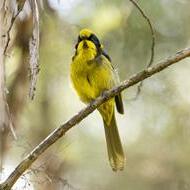
We care for 50 to 60 birds at Healesville Sanctuary.

In 2021, we bred 19 pairs and raised 24 juveniles to independence.
In 2021, we bred 14 pairs and raised 36 juveniles to independence.
In 2022–2023, Zoos Victoria will breed 20 pairs of birds. Some will be released into the breeding population; others will be released into the wild.
The 2022–2023 breeding season is underway, and the birds will be released into the wild in Autumn.
Your donation makes all the difference and goes towards important conservation work. If you would like to help fight for all our feathered friends that are facing extinction, you can donate through zoo.org.au/donate
Orange-bellied Parrots
HEALESVILLE SANCTUARY
Helmeted Honeyeaters
HEALESVILLE SANCTUARY
22ZVMAG
x3 x24
16
14
x ANIMAL
IMAGES (OPPOSITE): JO HOWELL, RICK HAMMOND
ESTATES
Zoos Victoria acknowledges the generosity of those who have given via a gift in their will.
A N & B O Williams Foundation
Kevin Stewart Cowell, a subfund of the State Trustees Australia Foundation
Estate of Patricia Downes
The HGK Bequest managed by Equity Trustees
Estate of Nancy Unice Jenner
Estate of Kathleen Millicent Lewellin
Estate of Betty Claire Lynch
Estate of Anthony James Major Merle Carroll Assistance Fund
Shirley Edith Poole, a sub-fund of the State Trustees Australia Foundation
Estate of Leonard Norman Robinson
Estate of Noelle Cynthia Schollenberger
Estate of Dawn Shoebridge
PHILANTHROPIC PARTNERS
Zoos Victoria acknowledges the generosity of those who give via our Philanthropic Conservation Partners program, including those who give anonymously.
VISIONARY
Anonymous (1)
LEADER
Meg Bentley
The Dyson Bequest
John T Reid Charitable Trusts Anonymous (1)
INFLUENCER
Lisa Cochrane and Scott Hipkins
Finkel Foundation
Baillieu Myer AC and Sarah Myer
Nick Sims on behalf of Goldman Sachs Gives
Zoo and Aquarium Association Australasia, Wildlife Conservation Fund Anonymous (1)
HERO
The Dyson Family The Fox Family Purryburry Trust Lady Southey AC Sunraysia Foundation
Vizard Foundation Volkswagen Group Australia
In memory of Dr JD Wilson
Helen Wilson Anonymous (1)
CHAMPION
S. Allender
Jay Bethell and Peter Smart
The Calvert-Jones Foundation
Brian Coe & Dave Sharp
Mark and Carol Collins
JMS Foundation
Cara Kwok
The Lin Huddleston Charitable Foundation
Naomi Milgrom Foundation
PETstock and Petspiration Foundation (formerly PETstock Assist)
In honour of John Seebeck
Shirley Sullivan Warranbrooke Pty Ltd
Stuart Webster Kim Wood
The Wood Foundation Anonymous (6)
FIGHTER
Allen & Unwin - Albert Street Books
B M Investments Pty Ltd Ken and Joy Barassi
The Bartolo Family Maxine Bowness
Debbie Carruthers
The Cattermole Family
Cincinnati Zoo & Botanical Garden
Alan and Jillian Cobb
Coote Family Lawyers
Debbie Dadon AM
David & Lone Ford
Simon and Christina Edelstein
The Garry White Foundation
Rose Gilder
ZV is published for Zoos Victoria by Hardie Grant Media
HARDIE GRANT MEDIA MANAGING DIRECTOR Nick Hardie-Grant ACCOUNT DIRECTOR Scott Elmslie EDITOR Georgia Lejeune DESIGN Dallas Budde, Keely Atkins PRINTER: Immij ZOOS VICTORIA: Angie Retallack, Ethan Jenkins.
Zoos Victoria PO Box 74, Parkville Vic 3052
P 03 9340 2780 / F 03 9285 9390
E contact@zoo.org.au
W zoo.org.au
Alexander Gosling AM and Wirat Sukprem
Lesley Griffin
Hallam-Ho Family
Angela Hey
The Hooper Family
In memory of Jean Margaret Howard
Ian Barker Gardens
Greg Jeffers and Alicia Vengust Suzanne Kirkham
Melody Ku and Jian An Lim Alexander and Nicholas Lee
Peter Lemon
In memory of Barbara Martyn McPhee Charitable Trust Kujtim Memishi
Microchips Australia
In honour of Helen Anderson Miller
Helen Myall and Alastair Firkin Nashville Zoo
Janice Pleydell Nola Schenk
Elaine and Richard Stradwick Anonymous (4)
Zoos Victoria also acknowledges the generosity of those who give anonymously to support our conservation initiatives.
Zoos Victoria acknowledges the ongoing annual funding from the Victorian State Government. Please visit our supporters page for further information: zoo.org.au/ donate/our-supporters/ *Donors are from the 2021/22 financial year.
Connect with us: Join the conversation on our social media channels. @ZoosVictoria on Twitter and Instagram.
Cover: Golden-rayed Blue Butterfly. (Illustration Phil Constantinesco/ The Illustration Room)
Printed on 100% recycled paper with vegetable-based inks. Zoos Victoria is a carbon neutral organisation.
23 SPRING/SUMMER 2022 PARTNERS


zoo.org.au/donate
